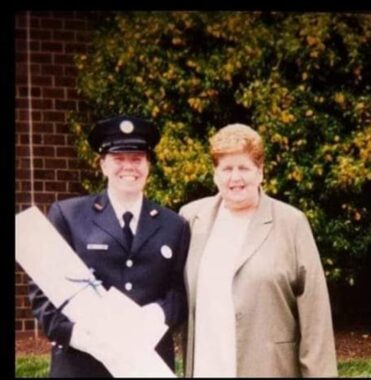Answering the call: What emergency responders do, Part 1
What work and life is like for a paramedic and an ER nurse

First in a series.
The rare disease community has an abundance of compliant patients and proficient caregivers. We do our best to avoid serious medical emergencies but are wise enough to know that we must also prepare for them.
Important healthcare information and prescription lists are diligently maintained and kept close at hand. To-go bags are packed and ready with the essentials needed for unexpected hospital stays. Many of us pray, meditate, journal, and even seek counseling to help ready our minds for worst-case scenarios.
But no matter how prepared we try to be, calling 911 can be unnerving for even the most experienced patients and caregivers.
On March 17, Michelle Roche, 51, a fire service paramedic, will celebrate 20 years with the Philadelphia Fire Department. I reached out to Michelle via email and asked if she would share her experiences and answer questions that could help future 911 callers. She was happy to oblige.

From left, Michelle Roche and her proud mom, Margaret Ebbinger, who inspired Michelle’s career, at the Philadelphia Fire Academy on May 2, 2003. (Courtesy of Michelle Roche)
Mom pointed Michelle in the right direction
Michelle was on summer break from classes when her mom, Margaret Ebbinger, mentioned that the Thomas Jefferson University Hospital in Philadelphia was offering an EMT course. Margaret suggested that it might be a great stepping stone for nursing school for Michelle.
“I took the class and fell in love with being the first on the scene to help people in need,” Michelle told me.
The following year, she took her career a step further and enrolled in a paramedic course.
Michelle describes herself as a caring person who is great at listening to patients. These qualities have helped her continue to love a job that has a high burnout rate.
What’s the difference between a firefighter/EMT and a paramedic?
Michelle explained that a firefighter/EMT can do fire suppression and perform basic lifesaving skills.
Paramedics perform advanced lifesaving skills such as handling intravenous medications, advanced airways, and EKG interpretations. They also receive some fire suppression training.
The reasons a fire truck may arrive before a paramedic unit
According to Michelle, there are numerous reasons why a fire truck might be sent before a paramedic unit. The proximity of the paramedic unit and the fire crew to the emergency influences who arrives first. A fire truck could also be sent to assist with larger patients, with equipment, or when a paramedic unit needs to go underground.
What to expect when help arrives
Michelle notes that 911 is an emergency response service, so they often only have minutes to respond to a scene, tend to a patient, and safely transport them. Having a patient’s medication list and proper identification helps keep things moving along quickly. Anything else can be brought to the hospital by the family.
When emergency medical providers arrive, someone needs to be able to give them a brief medical history of the patient and explain what is going on if the patient is unable to communicate at the time of the assessment. As a provider, Michelle arrives on the scene with equipment to evaluate a patient.
“I like to ask why 911 was dispatched and act as calmly as possible to make it an easy transition for the patient and the family,” Michelle wrote.
Whether it is a child or an adult, Michelle asks questions about the patient’s interests to help calm them and take their mind off the distress. “Sometimes there is not time to do that,” she said.
Michelle provides oxygen if needed, uses a monitor to do an EKG, and brings in equipment to carry the patient to the paramedic unit.
I asked Michelle how they handle complicated situations such as pulmonary hypertension patients on continuous intravenous Flolan (epoprostenol GM) or Remodulin (injectable treprostinil). She explained that paramedics have protocols to follow as a guideline to treat patients.
“Sometimes we may call our medical command doctors for guidance or for orders if it is in our scope of practice as paramedics,” she wrote.
Another big question is whether caregivers can ride with patients to the hospital. Michelle said that the only time they can’t is if they are hindering care or there isn’t enough room in the back of the paramedic unit because additional resources are needed.
Why she does what she does
“As a paramedic, I can respond to what could be the worst day of someone’s life, and despite having 20 years in the fire department, I still find it challenging to tell someone their loved one has passed,” she said.
But Michelle also remembers countless rewarding experiences, and it’s the smiles and praises after getting patients to the hospital that she values the most.
“Working as a paramedic for the City of Philadelphia is the best job in the world,” Michelle stated proudly, adding, “I have learned so much!”
Next week, Linda Wrigley shares her experience as an ER nurse and offers advice for patients and caregivers.
Note: Pulmonary Hypertension News is strictly a news and information website about the disease. It does not provide medical advice, diagnosis, or treatment. This content is not intended to be a substitute for professional medical advice, diagnosis, or treatment. Always seek the advice of your physician or other qualified health provider with any questions you may have regarding a medical condition. Never disregard professional medical advice or delay in seeking it because of something you have read on this website. The opinions expressed in this column are not those of Pulmonary Hypertension News or its parent company, Bionews, and are intended to spark discussion about issues pertaining to pulmonary hypertension.









Leave a comment
Fill in the required fields to post. Your email address will not be published.